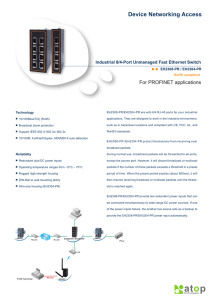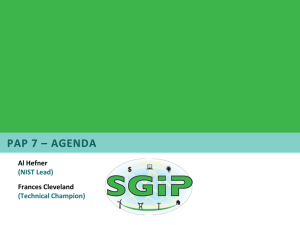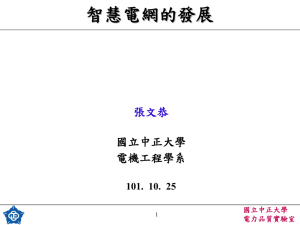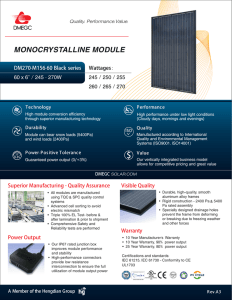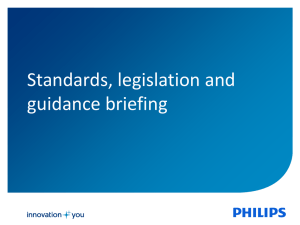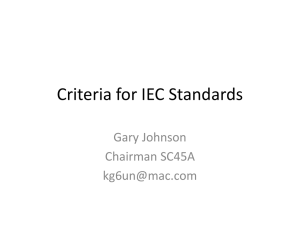Fire Safety in Electrical Engineering & Electronics (E&E)
advertisement
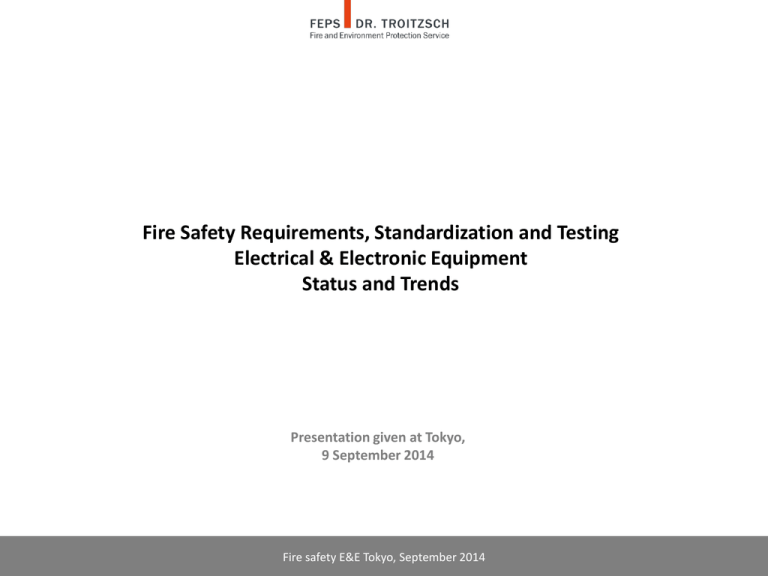
Fire Safety Requirements, Standardization and Testing Electrical & Electronic Equipment Status and Trends Presentation given at Tokyo, 9 September 2014 Fire safety E&E Tokyo, September 2014 Fire Safety in Electrical Engineering & Electronics (E&E) in Europe In E&E, general safety requirements including fire safety are defined in the European Low Voltage (LVD) and the Electromagnetic Compatibility (EMC) Directives Specific fire safety requirements (in the EU: essential requirements) and flammability tests are contained in international standards (IEC, CENELEC for the EU), and the corresponding national standards Manufacturers set up Document of Conformity (DOC) based on Technical Files Fire safety E&E Tokyo, September 2014 Fire Safety in Electrical Engineering & Electronics (E&E) The main flammability tests for E&E are the Bunsen burner based UL 94 tests and the glow wire tests. They basically reflect primary, low energy ignition sources inside of E&E equipment External, candle-like ignition sources igniting E&E equipment from the outside have been considered for consumer and IT electronics. They have been introduced in Europe Flammability requirements in E&E mainly apply for IT, audio/video, appliances, technical parts and lighting The flammability test requirements are basically UL 94 HB, V2 to V0. In addition the needle flame test may be used For appliances, the glow wire tests are largely used in Europe Fire safety E&E Tokyo, September 2014 Course of a fire and small ignition sources Small ignition sources are the cause of most fires. Preventing and delaying their impact Is essential to avoid flashover Fire safety E&E Tokyo, September 2014 Fire Safety in Electrical Engineering & Electronics (E&E) The main flammability tests for E&E are the Bunsen burner based UL 94 tests and the Needle Flame test Vertical test to IEC 60695-11-10 (UL 94 V0, V1, V2) 50 W flame Test to IEC 60695-11-20 (UL 94 , 5VA, 5VB) 500 W flame Needle Flame test to IEC 60695-11-5 Fire safety E&E Tokyo, September 2014 Appliances Glow Wire Test The European standard EN 60335-1 ”Household and similar electrical appliances – Safety” addresses fire safety requirements in Section 30 “Resistance to Heat and Fire” The most important flammability test for appliances in Europe is the glow wire test Fire safety E&E Tokyo, September 2014 Requirements to IEC 60695-2-11 to -13 Unattended Connection > 0.2 A IEC/EN 60695-2-11 Flammability end products (GWT) 750°C < 2 s required in IEC 335 if > 2 s Needle flame test to IEC 60695-11-5 or Class V0 or V1 to IEC 60695-11-10 IEC/EN 60695-2-12 Flammability materials (GWFI) 850°C < 30 s IEC/EN 60695-2-13 Ignitability materials (GWIT) 775°C < 5 s Fire safety E&E Tokyo, September 2014 Glow Wire Standards to IEC 60695-2 revised in 2013 IEC/EN 60695-2-10 (VDE 0471-2-10) Glow wire Apparatus and common test procedure IEC/EN 60695-2-11 (VDE 0471-2-11) Glow wire Flammability test for end products (GWT) IEC/EN 60695-2-12 (VDE 0471-2-12) Glow wire Flammability test for materials (GWFI) IEC/EN 60695-2-13 (VDE 0471-2-13) Glow wire Ignitability test for materials (GWIT) No major changes in the revised standards Fire safety E&E Tokyo, September 2014 External ignition sources External ignition sources for consumer electronics and IT equipment were developed in the technical specification IEC/TS 62441 “Accidentally caused candle flame ignition” and foreseen to be introduced in the IEC 60065 standard The TS describes fire hazards from external ignition sources, requiring materials (> 300 g) to meet Class UL94 V1 However, its introduction has been rejected by an IEC vote in 2010, following an American NGO activists’ campaign against flame retardants At the same time, it has been taken over in the corresponding European EN 60065 standard Fire safety E&E Tokyo, September 2014 Fire Safety in Electrical Engineering & Electronics (E&E) The revision of the new standard IEC 62368-1 “Audio/video, information and communication technology equipment - Part 1: Safety requirements” also considers external ignition sources IEC 62368 is a merger of the standards IEC 60065 for consumer electronics and IEC 60950-1 for IT equipment and will substitute them In a new campaign, the same activists succeeded again to initiate a negative vote, so that the introduction of the external ignition sources in IEC 62368-1 has been rejected in May 2012 These campaigns against flame retardants in general may reduce the fire safety levels of consumers and IT equipment in the future and lead to increased threats to human life and material damages Fire safety E&E Tokyo, September 2014 may dram Fire Safety in Electrical Engineering & Electronics (E&E) The dramatic effects of external ignition sources on TV sets is shown in the following videos Videos (to be included into the presentation) Test on television 32 inch Test on television 40 inch Fire safety E&E Tokyo, September 2014 Fire tests wire & cable IEC 60332-1: Tests on electric and optical fibre cables under fire conditions - Part 1-2: Test for vertical flame propagation for a single insulated wire or cable - Procedure for 1 kW pre-mixed flame (IEC 60332-1-2:2004) IEC 60332-2. Part 2-2: Test for vertical flame propagation for a single small insulated wire or cable - Procedure for diffusion flame (IEC 60332-2-2:2004) IEC 60332-3. Tests on electric and optical fibre cables under fire conditions - Part 3: Test for vertical flame spread of vertically-mounted bunched wires or cables Modified IEC 60332-3 Test for construction products: EN 50265-2-1/2 with hood for measuring rate of heat release (Basis FIPEC) Fire safety E&E Tokyo, September 2014 Fire tests wire & cable Flame propagation tests to IEC 60332-1 and -2 IEC 60332-1: Single insulated wire IEC 60332-2: Single small insulated wire Fire safety E&E Tokyo, September 2014 Fire tests wire & cable Modified IEC 60332-3 Test for construction products: EN 50265-2-1/2 Flame propagation Heat release (O2 consumption) CO2 concentration Smoke measurement Fire safety E&E Tokyo, September 2014 Photovoltaics: Problems for fire safety Photovoltaics (PV): Generating electrical power by converting solar radiation into direct current electricity Light is converted into electrical power by semi-conductors Several inter-connected solar cells form a solar module Although fire safety problems do not occur frequently, they may take place more often in the future because of the increasing growth of this technology Fire safety E&E Tokyo, September 2014 Photovoltaics: Problems for fire safety In 2009, the world largest photovoltaics roofing site took fire in Bürstadt, Germany, destroying 80 m² of the solar modules Fire causes are frequently faulty electrical connections within the modules leading to overheating and fire initiation Fire safety E&E Tokyo, September 2014 Photovoltaics: Problems for fire safety To date, only limited experience of fire brigades in PV-equipment fires Problem: Due to light radiation, solar modules and their components are virtually always live with direct current voltage up to 1,000 V This may lead to deadly electrical shock during fire-fighting To this end, guidelines and data sheets have been published. Standardization however, is still in its infancy Fire safety E&E Tokyo, September 2014 Conclusions E&E ignition/flammability tests address the beginning of an initiating fire They have shown to prevent or delay fires from E&E materials and end products Fire tests simulating open flames and malfunction of electrical parts (glow wire) have shown to be very effective External open flame tests for consumer/IT devices help to improve fire safety Tests for wire & cable flame propagation contribute to fire safety in many applications for building/construction and transportation Photovoltaics fire safety is of growing importance Fire safety E&E Tokyo, September 2014

